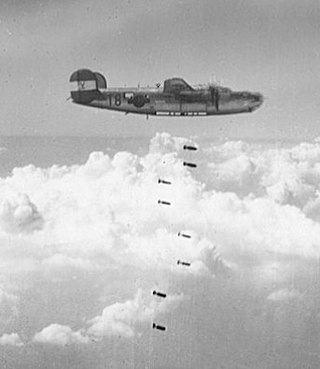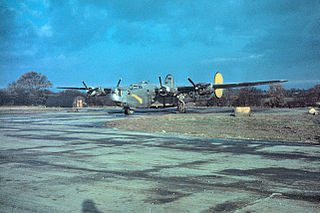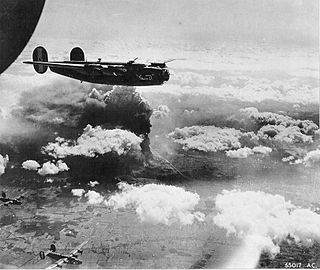
The 458th Air Expeditionary Group is a provisional United States Air Force unit assigned to United States Air Forces in Europe to activate or inactivate as needed. The most recent known activation of the unit was at Ramstein Air Base, Germany in 2011.

The 493d Bombardment Group is a former United States Army Air Forces unit that was assigned to the 92d Bombardment Wing during World War II. It the last bombardment group to be assigned to Eighth Air Force. It flew combat missions in the strategic bombing campaign against Germany until shortly before V-E Day, then returned to the United States for inactivation. In 2002, the group was converted to provisional status as the 493d Air Expeditionary Group and assigned to Air Mobility Command to activate or inactivate as needed.

The 489th Bomb Group is a unit of the United States Air Force within the Air Force Reserve Command. It is assigned to the 307th Bomb Wing, and is stationed at Dyess Air Force Base, Texas. The group is a reserve associate unit of the 7th Bomb Wing at Dyess.

The 491st Bombardment Group is a former United States Army Air Forces unit. It was activated in October 1943 as a heavy bomber unit, drawing its cadre from the former 17th Antisubmarine Squadron. After training in the United States, the group deployed to the European Theater of Operations, where it participated in the strategic bombing campaign against Germany, earning a Distinguished Unit Citation in an attack against Misburg. The group flew 187 combat missions. Following V-E Day, the group returned to the United States and was inactivated at McChord Field, Washington in September 1945.

The 55th Air Refueling Squadron is an inactive United States Air Force unit. It formerly operated both the combat crew training school and central flight instructor course for Boeing KC-135 Stratotanker at Altus Air Force Base, Oklahoma.

The 847th Bombardment Squadron is a former United States Army Air Forces unit that was originally activated as the 421st Bombardment Squadron. Its last assignment was with the 489th Bombardment Group at Great Bend Army Air Field, Kansas where it was inactivated on 28 March 1945. As the 20th Antisubmarine Squadron, the squadron performed antisubmarine patrols in 1942 and 1943. After reforming as a heavy bomber squadron, it engaged in the strategic bombing campaign against Germany in the European Theater of Operations until returning to the United States in late 1944. The squadron was inactivated while its parent group was training as a very heavy bombardment unit.

The 863rd Bombardment Squadron is a former United States Army Air Forces unit. It was first organized as the 518th Bombardment Squadron in October 1942, when it replaced a National Guard unit participating in antisubmarine patrols off the Atlantic coast, becoming the 13th Antisubmarine Squadron in November. When the Navy took over the coastal antisubmarine mission in August 1943, the squadron moved to the western United States, where it formed the cadre for the 493rd Bombardment Group and was redesignated as the 863rd. It moved to England in the spring of 1944 and participated in the strategic bombing campaign against Germany until April 1945. It returned to the United States and was inactivated in August 1945.

The 856th Bombardment Squadron was a United States Army Air Forces unit. it was first activated in October 1943 as one of the original Consolidated B-24 Liberator squadrons of the 492d Bombardment Group. After deploying to England, the 492d entered the strategic bombing campaign against Germany, but in three months of combat, the 492d Group suffered the most severe losses of an Eighth Air Force bomber group. The 492d Group was withdrawn from combat in August 1944, and the 856th moved on paper to replace the 36th Bombardment Squadron, which was engaged in Operation Carpetbagger, dropping agents and supplies behind German lines, primarily in France. As American forces advanced in France, this special operations mission diminished. The squadron briefly transported fuel to mechanized units in France, then returned to special operations in Scandinavia and Germany under the operational control of Eighth Air Force until the end of hostilities in Europe. It returned to the United States for conversion to Boeing B-29 Superfortresses, but was inactivated in October 1945.

The 857th Bombardment Squadron is one of the two predecessors of the 557th Tactical Air Support Squadron, an inactive United States Air Force unit, formed in 1985 by the consolidation of the 857th with another inactive bombardment squadron. It has never been active under its most recent designation.

The 829th Bombardment Squadron was a squadron of the United States Army Air Forces. It was active during World War II in the Mediterranean Theater of Operations as a Consolidated B-24 Liberator unit, where it earned a Distinguished Unit Citation. Following V-E Day, the squadron returned to the United States and began training with the Boeing B-29 Superfortress at Smoky Hill Army Air Field, Kansas, before inactivating in August 1946.

The 828th Bombardment Squadron was a squadron of the United States Army Air Forces. It was active during World War II in the Mediterranean Theater of Operations as a Consolidated B-24 Liberator unit, where it earned a Distinguished Unit Citation. Following V-E Day, the squadron returned to the United States and began training with the Boeing B-29 Superfortress at Smoky Hill Army Air Field, Kansas, before inactivating in August 1946 ans transferring its personnel to another unit that was activated in its place.

The 752nd Bombardment Squadron is a former United States Army Air Forces unit. The squadron was first activated in July 1943. After training with Consolidated B-24 Liberator heavy bombers in the United States, it deployed to the European Theater of Operations, where it participated in the strategic bombing campaign against Germany. Following V-E Day, the squadron returned to the United States, where it began training with Boeing B-29 Superfortresses, but was inactivated in October 1945.

The 785th Bombardment Squadron is a former United States Army Air Forces unit. It was organized in August 1943 as a heavy bomber unit. After training in the United States with Consolidated B-24 Liberators, the 785th moved to England, where it participated in the strategic bombing campaign against Germany. Following V-E Day, it returned to the United States, where it began training with Boeing B-29 Superfortresses, but was inactivated in October 1945.

The 844th Bombardment Squadron is an inactive United States Air Force unit. It was assigned to the 489th Bombardment Group, flying Consolidated B-24 Liberators. After training in the United States, it moved to England and engaged in the strategic bombing campaign against Germany until V-E Day. It returned to United States in 1945 and began training with the Boeing B-29 Superfortress, but was inactivated at March Field, California on 17 October 1945.

The 845th Bombardment Squadron is an inactive United States Air Force unit. It was last assigned to the 489th Bombardment Group. It was assigned to the 489th Bombardment Group, flying Consolidated B-24 Liberators. After training in the United States, it moved to England and engaged in the strategic bombing campaign against Germany until V-E Day. It returned to United States in 1945 and began training with the Boeing B-29 Superfortress, but was inactivated at March Field, California on 17 October 1945.

The 860th Bombardment Squadron is a former United States Army Air Forces unit that was assigned to the 493d Bombardment Group during World War II. It was part of the last bombardment group to be assigned to Eighth Air Force. It flew combat missions until V-E Day, then returned to the United States for inactivation. In 1985, the squadron was consolidated with the 660th Bombardment Squadron, a Strategic Air Command unit that flew Boeing B-47 Stratojets during the Cold War. Although the two squadrons were consolidated as the 967th Airborne Warning and Control Squadron, they have never been active under that designation.

The 788th Tactical Fighter Squadron is an inactive United States Air Force unit. During World War II, as the 788th Bombardment Squadron, it was assigned to the 467th Bombardment Group as a Consolidated B-24 Liberator squadron in 1943. After training in the United States, it moved to the European Theater of Operations the following year. It saw combat until the surrender of Germany in May 1945, earning a French Croix de Guerre with Palm for its actions contributing to the liberation of France. From May to August 1944, the squadron was detached to the 801st Bombardment Group (Provisional) engaging in Operation Carpetbagger operations. After V-E Day, the squadron returned to the United States and transitioned into the Boeing B-29 Superfortress It was inactivated on 4 August 1946 at Clovis Army Air Field, New Mexico.

The 789th Tactical Fighter Squadron is an inactive United States Air Force unit. During World War II, as the 789th Bombardment Squadron, it was assigned to the 467th Bombardment Group as a Consolidated B-24 Liberator squadron in 1943. After training in the United States, it moved to the European Theater of Operations the following year, where it participated in the strategic bombing campaign against Germany. It saw combat until the surrender of Germany in May 1945. After V-E Day, the squadron returned to the United States and transitioned into the Boeing B-29 Superfortress It was inactivated on 4 August 1946 at Clovis Army Air Field, New Mexico.

The 790th Bombardment Squadron is a former United States Army Air Forces unit, established as a Consolidated B-24 Liberator squadron in 1943. After training in the United States, it moved to the European Theater of Operations the following year. During World War II it was assigned to the 467th Bombardment Group, and engaged in the strategic bombing campaign against Germany. After V-E Day, the squadron returned to the United States and transitioned into the Boeing B-29 Superfortress. It was inactivated on 4 August 1946 at Clovis Army Air Field, New Mexico in March 1946 and its resources were transferred to another unit.

The 791st Bombardment Squadron is a former United States Army Air Forces unit. During World War II it was assigned to the 467th Bombardment Group, and engaged in the strategic bombing campaign against Germany. After V-E Day, the squadron returned to the United States and transitioned into the Boeing B-29 Superfortress. It was inactivated on 31 March 1946 at Roswell Army Air Field, New Mexico in March 1946 and its resources were transferred elsewhere.














